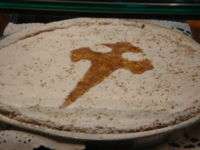Tarta de Santiago
|
Typical presentation with the Cross of the Order of Santiago | |
| Course | dessert |
|---|---|
| Place of origin | Spain |
| Region or state | Galicia |
| Serving temperature | chilled/room temperature |
| Main ingredients | ground almonds |
|
Torta de Santiago (Galician)|Cookbook: Tarta de Santiago (Spanish) Torta de Santiago (Galician)]] Torta de Santiago (Galician)|Media: Tarta de Santiago (Spanish) Torta de Santiago (Galician)]] | |
Torta de Santiago (in Galician) or Tarta de Santiago (in Spanish), literally meaning cake of St. James, is an almond cake or pie from Galicia with origin in the Middle Ages. The Galician name for cake is Torta whilst it is often referred to Tarta, which is the Spanish word. The filling principally consists of ground almonds, eggs, and sugar, with additional flavouring of lemon zest, sweet wine, brandy, or grape marc, depending on the recipe used.[1] It is a round shape and can be made with or without a base which can be either puff pastry or shortcrust pastry. The top of the pie is decorated with powdered sugar, masked by an imprint of the Cross of Saint James (cruz de Santiago) which gives the pastry its name.
In May 2010, the EU gave Tarta de Santiago PGI status within Europe. To qualify, the cake must be made in the Autonomous Community of Galicia and contain at least 33% almonds, excluding the base.[1]
It was the sweet chosen to represent Spain in the Café Europe initiative of the Austrian presidency of the European Union on Europe Day 2006.
See also
References
- 1 2 "COUNCIL REGULATION (EC) No 510/2006 'TARTA DE SANTIAGO' EC No: ES-PGI-0005-0616-03.07.2007". DOOR. Retrieved 6 April 2014.
| Wikimedia Commons has media related to Tarta de Santiago. |



